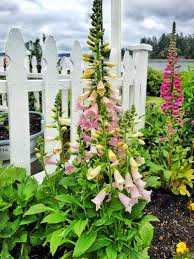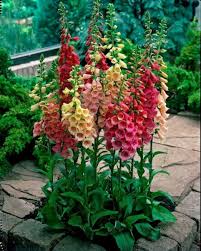Foxglove flowers, also known by their scientific name Digitalis purpurea, are a captivating sight in any garden or natural landscape. These stunning biennial plants belong to the family Plantaginaceae and are native to Europe. They have become popular ornamental plants worldwide due to their distinctive appearance and delightful charm.
Foxglove flowers are easily recognizable by their tall, spire-like clusters of tubular blooms that rise above the plant’s foliage. The flowers come in various shades, including pink, purple, white, and sometimes yellow. Each blossom is adorned with beautiful speckles or freckles on the inside, enhancing their allure. The plants can reach an impressive height of up to six feet, adding vertical interest to any garden.
Foxgloves are not difficult to grow, making them an excellent choice for both seasoned gardeners and beginners alike. They thrive in well-draining soil with partial to full sunlight, although they can tolerate some shade. Gardeners should sow their seeds in late spring or early summer, and with a little patience and care, the flowers will bloom in the following year.
While foxglove flowers are undoubtedly enchanting, it’s crucial to handle them with care. All parts of the plant contain potent cardiac glycosides, which can be toxic if ingested. Therefore, it’s essential to keep foxgloves away from curious pets and young children and always wear gloves when handling them.
Beyond their aesthetic value, foxglove flowers play a crucial role in supporting local ecosystems. They are a favorite of bees and other pollinators, providing them with a rich source of nectar and pollen. By attracting these essential insects, foxgloves contribute to the pollination of other plants, ensuring a healthy and diverse environment.
Despite their toxicity, foxglove flowers have a long history of medicinal use. The plant’s cardiac glycosides, such as digitalis, have been used to treat heart-related conditions for centuries. However, it’s crucial to emphasize that using foxglove for medicinal purposes should only be done under the supervision of a qualified healthcare professional, as incorrect dosages can be dangerous.
Throughout history, foxglove flowers have been associated with various myths and legends. In Celtic folklore, they were believed to be the homes of fairies. In medieval times, foxgloves were linked to magic and witches, adding to their mystique.
While foxgloves are undoubtedly a beautiful addition to any garden, their toxic nature means they are not suitable for households with pets or small children who may accidentally ingest the plant.
However, foxglove flowers are a true wonder of nature, blending elegance and allure with a rich historical and ecological significance. When grown responsibly and admired from a safe distance, they can add a touch of magic to any garden or natural setting, bringing joy and fascination to all who behold them.
Read Also: Dragon Flowers (Dracunculus Vulgaris): Complete Growing and Care Guide
History and Significance of Foxglove Flowers

Foxglove flowers, with their enchanting beauty and fascinating properties, have a rich history that stretches back through the ages. From ancient folklore to modern medicine, these blooms have left a significant mark on human culture and society.
Foxglove flowers have deep roots in ancient folklore and mythology. In Celtic traditions, these flowers were associated with fairies and believed to be the abodes of woodland spirits. It was considered bad luck to harm the foxgloves, as doing so might anger the fairies and invite misfortune.
During the medieval period, foxglove flowers were considered both magical and dangerous. They were believed to have mystical powers and were often used in various rituals and charms. At the same time, people were cautious around these plants due to their toxic nature. The association with magic and witches added to the aura of mystery surrounding foxgloves.
The medicinal properties of foxglove were recognized as early as the 18th century. In 1775, the English physician William Withering published a book titled “An Account of the Foxglove and Some of Its Medical Uses.” In this groundbreaking work, he described how extracts from the plant, particularly digitalis, could be used to treat heart conditions like dropsy (edema) and heart failure.
Over time, digitalis became a vital medicine in the treatment of heart ailments, and its use continued well into the 20th century. However, the potency and potential toxicity of foxglove necessitate extreme caution in its medical application, and modern pharmaceuticals have largely replaced its direct use.
Foxglove flowers have inspired many writers and poets throughout history. They have been mentioned in various literary works, often symbolizing beauty, danger, and enchantment. The famed Romantic poet John Keats, in his poem “The Eve of St. Agnes,” vividly described “lurk[ing] unseen” foxgloves, creating an eerie and mysterious atmosphere.
In the gardening world, foxglove flowers gained popularity for their ornamental value. They were introduced into cultivated gardens in the 19th century, and since then, they have become a beloved addition to cottage gardens and floral displays. The tall, majestic spikes of foxgloves add vertical interest and a touch of wild elegance to landscapes.
Beyond their cultural and historical significance, foxglove flowers also play a vital role in supporting biodiversity. Their nectar-rich blossoms attract bees, butterflies, and other pollinators, making them an essential part of the ecosystem. In many regions, efforts are made to preserve native foxglove populations to maintain the delicate balance of local flora and fauna.
In addition, foxglove flowers have a captivating history that intertwines ancient beliefs, medicinal breakthroughs, literary references, and ornamental beauty. As these delightful blooms continue to grace gardens and natural landscapes, their allure and importance in both cultural heritage and ecological balance remain timeless.
Uses of Foxglove Flowers

Foxglove flowers, also known as Digitalis purpurea, have been utilized in various ways throughout history. From ancient folklore to modern medicine, these beautiful blooms have found multiple applications, each one adding to their significance.
1. Medicinal Purposes:
One of the most significant uses of foxglove flowers is in medicine. The plant contains potent cardiac glycosides, such as digitoxin and digoxin, which have a remarkable effect on the heart. In the past, extracts from the foxglove plant were used to treat heart conditions like dropsy and heart failure. However, due to the narrow therapeutic window and risk of toxicity, modern medicine now employs safer and more precisely dosed pharmaceuticals for cardiac ailments.
2. Ornamental Plant:
Foxglove flowers have gained popularity as ornamental plants in gardens worldwide. Their tall, spire-like clusters of tubular blossoms in shades of pink, purple, white, and yellow add a touch of natural elegance to any landscape. As biennial plants, they self-seed, making them relatively easy to grow and maintain, attracting both seasoned and novice gardeners.
3. Wildlife Attraction:
The nectar-rich flowers of foxgloves make them a favorite among pollinators, such as bees and butterflies. By attracting these essential insects, foxgloves play a crucial role in pollination, supporting biodiversity and the health of the ecosystem.
4. Folklore and Cultural Symbolism:
Throughout history, foxglove flowers have been steeped in folklore and cultural symbolism. In Celtic beliefs, they were associated with fairies and woodland spirits, and harming the plants was considered bad luck. In literature and poetry, they have been used to symbolize beauty, enchantment, and the mystical world.
5. Natural Dye:
In the past, the leaves of the foxglove plant were used to create a natural dye. The leaves contain tannins and were used to produce shades of green and yellow for textiles and other materials.
6. Gardening and Landscaping:
Besides being ornamental plants, foxgloves are often used in gardening and landscaping to add vertical interest to flower beds and borders. Their tall flower spikes create a striking focal point, complementing other plants and adding a wild, cottage-garden charm.
7. Educational Purposes:
In educational settings, foxglove flowers can be valuable teaching tools. They provide opportunities to learn about the ecosystem, pollination, and plant biology. However, it’s essential to emphasize their toxic nature and the importance of handling them with care and caution.
8. Traditional Remedies (with caution):
In some traditional systems of medicine, foxglove flowers or extracts were historically used for various conditions. However, due to their toxic nature, these traditional remedies should never be attempted without proper medical guidance and supervision.
In addition, foxglove flowers have a diverse range of uses, from their historical significance in medicine and folklore to their role as ornamental garden plants and pollinator attractors. While they no longer serve as a primary medicinal remedy due to their toxicity, their enduring allure and ecological value continue to make them a cherished part of our natural world and cultural heritage.
Read Also: Best Flowers: All You Need To Know About
Complete Growing Guide of Foxglove Flowers

Growing foxglove flowers (Digitalis purpurea) can be a rewarding experience, as these beautiful blooms add a touch of elegance to any garden. Here’s a step-by-step guide to help you successfully cultivate these captivating plants:
1. Choosing the Right Location:
Select a suitable location for your foxglove plants. They prefer partial to full sunlight, but they can also tolerate some shade. Ensure the area has well-draining soil, as foxgloves do not thrive in waterlogged conditions.
2. Sowing Seeds or Transplanting:
Foxgloves can be grown from seeds or transplants. If planting seeds, do so in late spring or early summer, as they require a period of cold stratification to germinate successfully. Sow the seeds on the soil surface and gently press them in, as they need light to germinate. Transplants can be planted in spring or fall.
3. Soil Preparation:
Prepare the soil before planting. Loosen it to a depth of about 6 inches and amend with compost to improve fertility and drainage. Foxgloves prefer slightly acidic to neutral soil, with a pH range of 6.0 to 7.0.
4. Planting and Spacing:
If sowing seeds directly, space them about 12 to 18 inches apart to allow enough room for growth. If transplanting, space the plants accordingly. Plant the seeds or transplants at the same depth they were in their pots or seed trays.
5. Watering:
Keep the soil consistently moist, but not waterlogged, during the growing season. Water at the base of the plant to avoid wetting the leaves, as excessive moisture on the foliage can lead to fungal diseases.
6. Mulching:
Applying a layer of organic mulch around the base of the plants can help retain moisture, suppress weed growth, and regulate soil temperature. Mulch can also provide additional nutrients as it breaks down.
7. Supporting Tall Stems:
As foxgloves grow, their tall flower spikes may need support to prevent them from bending or breaking. You can use stakes or a ring-type support structure to gently prop up the stems.
8. Deadheading:
To encourage prolonged flowering, regularly deadhead (remove) spent blooms by cutting them off at the base. This practice will redirect the plant’s energy into producing new flowers.
9. Pests and Diseases:
Foxgloves are relatively pest-resistant, but they can be affected by aphids, slugs, and snails. Keep an eye out for these pests and take appropriate measures to manage them if necessary. Avoid overwatering to prevent fungal diseases.
10. Biennial Nature:
Keep in mind that foxgloves are biennial plants, meaning they have a two-year life cycle. In the first year, they focus on vegetative growth, and in the second year, they bloom and set seeds. After flowering and seed production, the plants will naturally die back.
11. Seed Collection:
If you want to propagate new foxglove plants, allow some of the flowers to go to seed in the second year. Once the seed pods turn brown, collect the seeds and store them in a cool, dry place for planting in the following growing season.
12. Toxicity Warning:
Remember that all parts of the foxglove plant are toxic if ingested. Keep them away from pets and children, and always wear gloves when handling them.
By following this comprehensive guide, you can successfully grow foxglove flowers and enjoy their enchanting beauty year after year. Happy gardening.
Read Also: What Kind Of Plastics Can Be Recycled?
